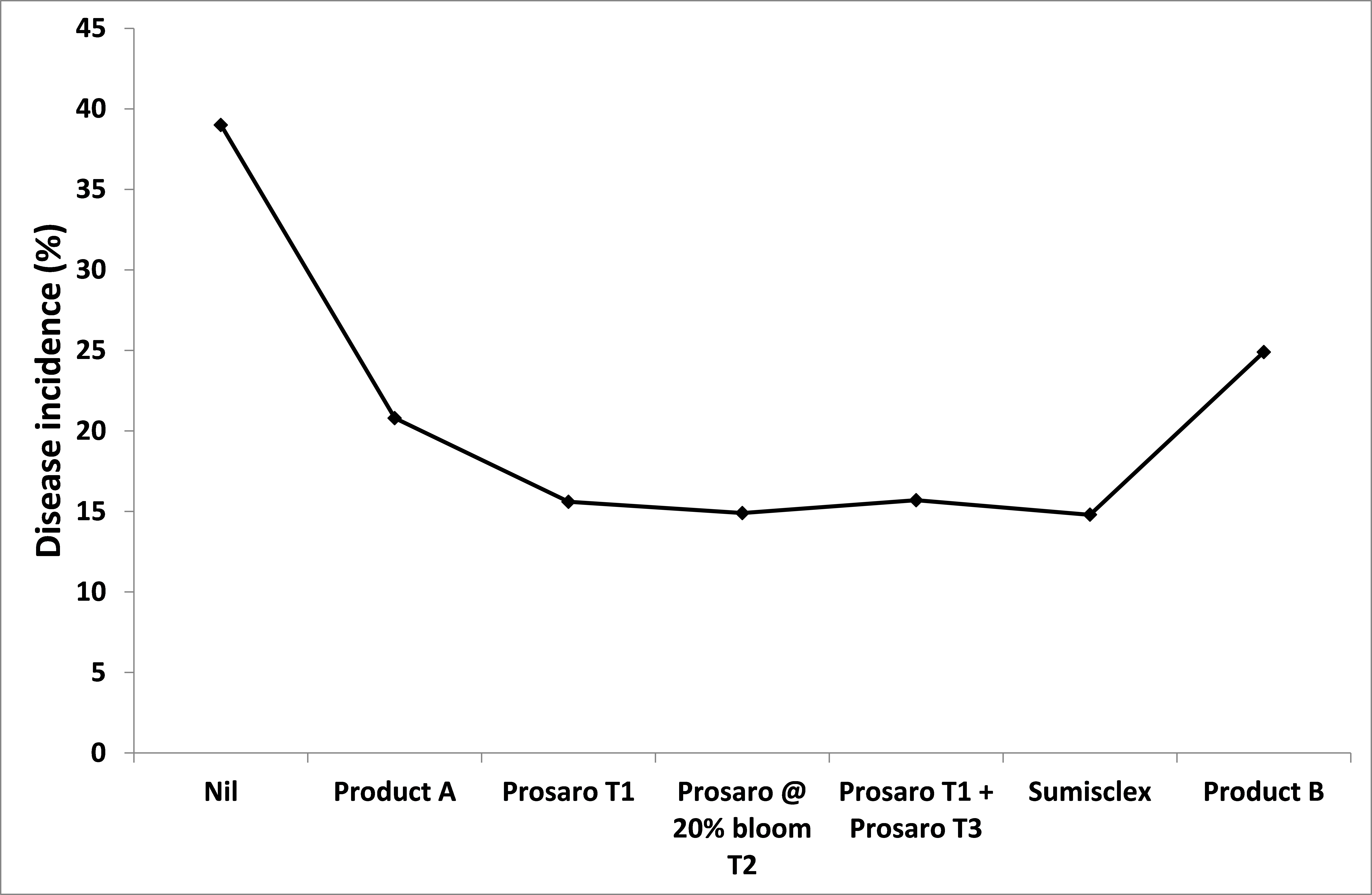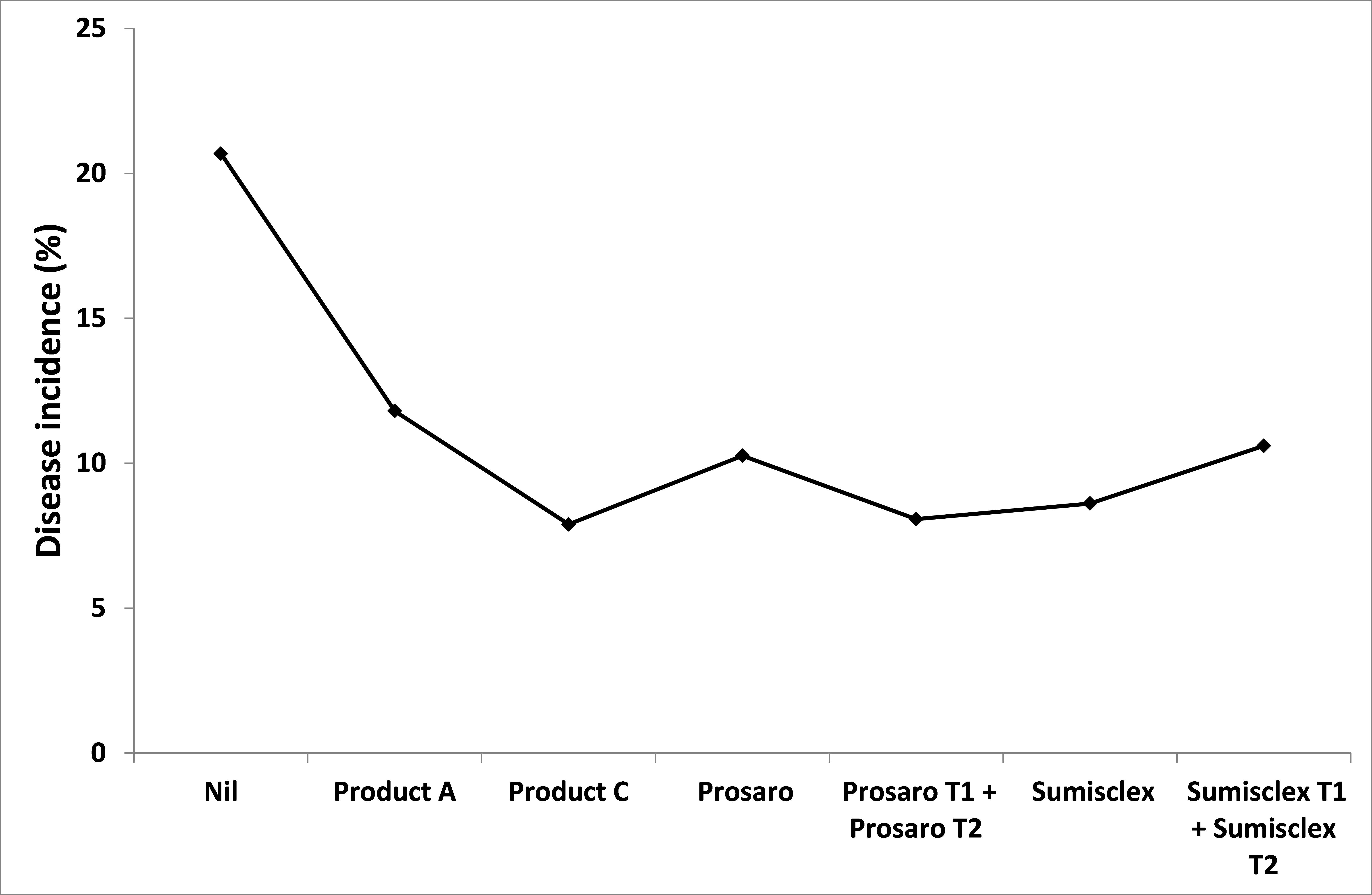Sclerotinia in canola- ground infections, effect of row spacing, plant density and fungicide. Is it worth spraying after you see the disease?
Author: Ravjit Khangura, Mehreteab Aberra and Stuart Vincent, Department of Agriculture and Food, Western Australia | Date: 27 Feb 2017
Key messages
- Seasonal conditions in 2016 allowed early germination of sclerotes, consequently triggering ground (basal) infection in several canola crops in the central and southern regions.
- Trials conducted in the northern region indicated that all fungicide spray timings targeted at different bloom stages were effective in reducing the disease incidence and improving the grain yield in canola. Net returns with different treatment timings ranged between $41-$148/ha. Disease incidence was also reduced in trials where fungicides were applied soon after detecting the ground infections.
- Wider row spacing (44cm) and lower plant density (15 plants/m2) had no effect in reducing disease incidence, however, disease incidence was significantly reduced and grain yield improved with the application of foliar fungicide at 30% bloom regardless of row spacing and plant density.
Aims
Sclerotinia stem rot caused by Sclerotinia sclerotiorum has recently emerged as a serious problem affecting canola crops in most of the canola growing regions of Western Australia. Due to lack of host resistance, the disease is currently managed through the use of fungicides and some cultural practices including long rotations with non-host crops and avoiding sowing in paddocks with the history of Sclerotinia. Since the onset of disease is unpredictable, it is essential to investigate the optimum timing of fungicide application over a number of years in order to develop disease management strategies based upon the seasonal conditions. Currently, Iprodione and procymidone and recently prothioconazole/tebuconazole based products are registered for the control of Sclerotinia. Fungicide resistance in Sclerotinia to certain products is already reported overseas therefore, having diversity of products with different active ingredients will help minimising the risk of developing fungicide resistance to a specific fungicide group. One of the major objectives of these investigations was to optimize timing of foliar fungicide application using currently registered and an unregistered alternative product for minimising losses from Sclerotinia in order to improve the profitability of canola production.
To reduce fungicide reliance for Sclerotinia control, role of some cultural practices needs to be evaluated. Sclerotinia requires good microclimatic conditions for disease development. It is anticipated that wider rows and/or lower plant density would facilitate good ventilation/air flow through the canopy, consequently, making conditions less ideal for the development of stem rot. Therefore, these studies were aimed at determining whether the combined effect of row spacing, plant density in conjunction with fungicide application has a synergistic effect in ameliorating the impact of Sclerotinia in canola.
Traditional Sclerotinia disease cycle involves primary stem infections via infected petals. However, over the last couple of years in particular in 2016 cropping season, ground or basal stem infections pre-flowering were very common in many canola growing areas of WA making fungicide spray decisions extremely difficult. In order to address this issue, field trials were conducted to control the secondary spread of the ground infections with some registered and unregistered products once the disease appears in the crop
Method
Fungicide timings
Field trials were conducted to investigate the optimal timing (s) for fungicide spray applications and the effectiveness of products for managing Sclerotinia in the canola growing regions of WA. At Moonyoonooka, var Hyola 404 was sown in a paddock and three different fungicides viz. prothioconazole (210g/L) + tebuconazole (210g/L) (Prosaro®) @450mL/ha, procymidone (500g/L) (Sumisclex®) @ 1L/ha and bixafen (75g/L) + prothioconazole (150g/L) (Product C) @ 800mL/ha were applied at various bloom stages as shown in Fig. 1.
Row spacing, plant density, variety and fungicide effects
Another field trial was also conducted in the Northern agricultural region to evaluate the effect of various agronomic factors on the incidence of Sclerotinia. The trial was sown with two different varieties (IH30RR and GT50), two row spacing (44 and 22 cm) and two targeted plant densities (30 and 15 plants/m2) with and without fungicide (Prosaro® ) applied at 30% bloom at the recommended rate.
Managing the spread of ground (basal) infections
Additionally, three different opportunistic trials (one each at New Norcia, Darkan and Arthur River) were established in grower’s paddocks where Sclerotinia ground (basal) infection had already appeared. Different fungicide including registered and unregistered products (4Farmers product X @1.22L/ha, Product A @ 1L/ha, Product B @ 1.5L/ha, Product C @ 800mL/ha, Prosaro® @ 450mL/ha, and Sumisclex® @1L/ha) were evaluated for their efficacy to manage Sclerotinia ground infection. Fungicides were generally applied as soon as basal infection was detected but at two sites two spray applications were included with Prosaro® at New Norcia and with Prosaro® and Sumisclex® at Arthur River. Second spray was applied 4 weeks after the first spray. Not all fungicide products were included in all trials (Figure 2). In each trial, disease incidence was recorded for all treatments and all plots were harvested for yield. Seed samples from all treatments were analysed for quality.
Results
Fungicide timings
Conditions were conducive for the early release of spores and disease development, consequently sufficient stem rot developed in the trial. The results indicated that the plants sprayed with each of the three fungicides (i.e Prosaro®, Sumisclex® or Product C) had significantly lower disease incidence than that the untreated ‘nil’. There was no difference in disease incidence among three fungicide treatments (data not shown). Disease incidence was significantly lower at all timings of spray compared with the nil.
There were significant yield responses to all fungicide treatments. The interaction between timing x fungicide was not significant. Maximum yield response was achieved with double spray application targeted at 10 and 50% bloom (Figure 1). The net return for various treatments ranged between $41 (10% bloom) to $148 (10+50% bloom). The net return is based on cost of Prosaro® ($33/ha), cost of single spray application ($7/ha) and current canola price $550/ha. Grain quality data is not yet available.

Figure 1. Main effect of fungicide timing averaged over fungicides on disease incidence (per cent plants infected) of Sclerotinia and grain yield (t/ha) of canola. Lsd (5%) for disease incidence = 7 and for yield = 0.170. Values above bars represent net return/ha ($) from fungicide application.
Row spacing, plant density, variety and fungicide effects
Seasonal conditions allowed substantial disease development in this trial. Only the main effects are presented here. Data indicated that row spacing and plant density had no effect in reducing disease levels, however disease incidence was significantly reduced with the application of fungicide and it was less in GT50 than in IH30RR (Table 1.) Likewise, grain yield was significantly improved with fungicide application, variety and higher plant density. Row spacing normal (22cm) or wider (44cm) had similar grain yield (Table 1). Grain quality data is not yet available.
Table 1: Main effects of fungicide, row spacing, plant density and variety on disease incidence of Sclerorinia stem rot (Sclerotinia sclerotiorum) and yield of canola.
|
Main factors |
DI |
Yield (Kg/ha) |
|---|---|---|
|
Fungicide |
||
|
Fungicide + |
6* |
3393* |
|
Fungicide - |
17.2 |
3130 |
|
Lsd (5%) |
4.8 |
176 |
|
Row spacing |
||
|
22 cm |
10 |
3244 |
|
44cm |
13 |
3279 |
|
Lsd (5%) |
5.7 |
176 |
|
Plant density |
||
|
15 plants/m2 |
11.5 |
3150 |
|
30 plants/m2 |
11.6 |
3372* |
|
Lsd (5%) |
4.9 |
204 |
|
Variety* |
||
|
IH30 RR |
16 |
3015 |
|
GT 50 |
8* |
3508* |
|
Lsd (5%) |
5.7 |
212 |
Letters in bold indicate significant treatment effects. * = significant treatments
Managing the spread of ground (basal) infections
Varying levels of ground infection were present at the time of establishing field trials. Trial data indicated that further spread of ground/basal infection was significantly controlled with all fungicide applications except for product B at New Norcia (Figure 2). Analysis of yield data for these trials is not available as yet, it is anticipated that it will be presented at the crop updates.
Conclusion
In 2016, conditions led to early spore release in most of the canola growing regions of WA providing substantial disease pressure in the field trials. In the Northern Agricultural region, conditions that were conducive to Sclerotinia continued throughout the growing season, extending flowering period as well as spore release. Consequently, fungicides applied at all bloom stages targeted at 10% through to 3 weeks after 50% bloom were effective in curtailing the disease and improving the yield in canola. Two spray applications at 10 and 50% bloom were most effective in reducing disease levels and improving yield of canola. These findings are in contrast to those previously reported from a similar trial conducted in the Southern region in 2015 where late spray applications applied at 60% bloom or 3 weeks after were uneconomical. This is possibly due to different seasonal conditions in two different growing seasons and different climatic conditions in the two growing regions. Net returns from spray application at various bloom stages were variable. The treatment of double spray (10 + 50% bloom) gave the maximum profit margin of $148/ha, followed by $118/ha, when sprayed at 50% bloom. Results clearly indicate that although single fungicide application effectively controlled the disease, two spray applications provided the maximum benefit particularly in a prolonged season.
Substantial disease pressure developed in a trial evaluating the effect of various cultural practices in managing stem rot. The data revealed that neither wide row spacing (44cm) nor lower plant density (15 plants /m2) effectively controlled the disease; however, fungicide application targeted at 30% bloom had a positive impact in reducing the disease levels and increasing the grain yield. Higher targeted plant density (30 plants /m2) significantly improved yield over lower plant density (15 plants /m2) even in a perfect growing environment. This finding is consistent with our previous findings although in previous years, growing conditions have been less than ideal in the trials. It is evident from the data that wide –row spacing and/or lower plant densities alone do not provide any advantage in reducing the disease levels, therefore, fungicide protection is still needed in order to minimise losses from Sclerotinia stem rot.

New Norcia

Darkan

Arthur River
Figure 2. Effect of fungicides on disease incidence of Sclerotinia stem rot at New Norcia, Darkan and Arthur River. Lsd (5%) for New Norcia, Darkan and Arthur River 15, 3 and 5 respectively.
Over the last few years, some ground infections of Sclerotinia have been reported to occur in pre-flowering canola. In the 2016 cropping season, substantially higher levels of such infections were observed in several crops particularly in the central and southern regions posing difficulties in decision making as to whether or not fungicide should be applied
to protect the crop. Data from three different trials indicated that fungicide applications significantly reduced the disease incidence possibly by reducing the secondary spread of the disease via contact and infection occurring via petals. Analysis of grain yield data is not available at this time but trial results suggest that there is a potential benefit in spraying soon after a crop is affected with basal infections.
All tested fungicide products (registered or unregistered) were effective in reducing the disease levels at all sites with one exception but the yield responses appeared to be variable. The results for some non-registered fungicide products with alternative chemistries for managing Sclerotinia seem to be promising.
Acknowledgments
We gratefully acknowledge GRDC for providing funding for this research. We thank Andrew Nixon, Tim Scott and Hamish Campbell for kindly allowing us to conduct trials at their properties. We also thank Geraldton and Katanning RSUs for excellent technical support in managing the trials.
Paper reviewed by: Dr Art Diggle, Dr Sally Peltzer, DAFWA.
GRDC Project Code: UM00051,
Was this page helpful?
YOUR FEEDBACK
